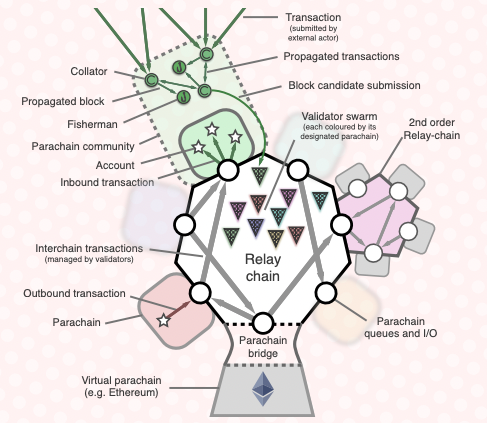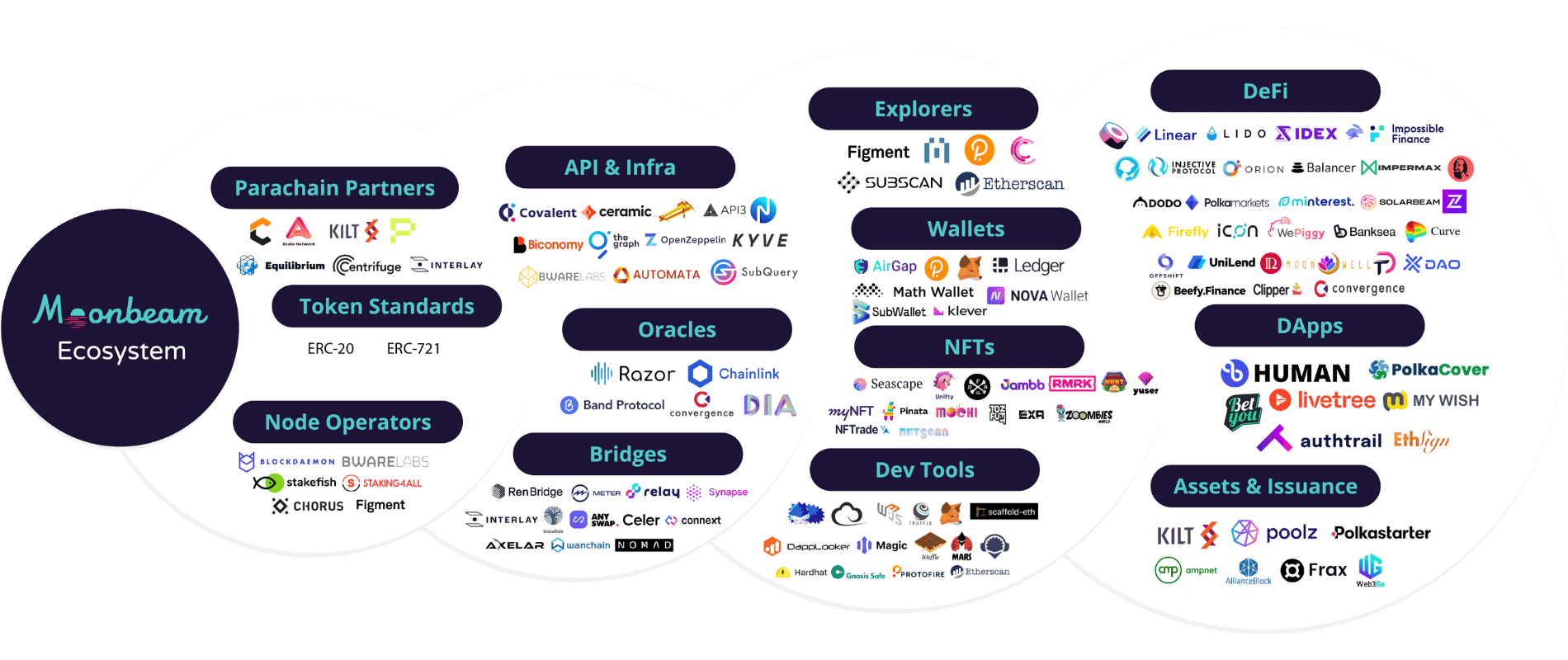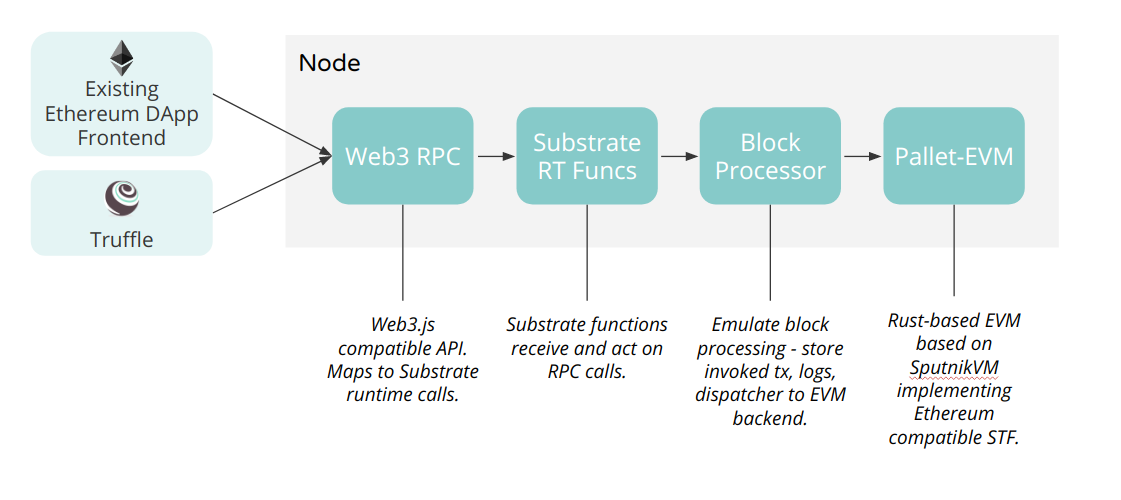
Moonbeam is a Polkadot-based blockchain with EVM compatibility (Ethereum Virtual Machine). It’s easy to take Moonbeam cross-chain because its network is connected to Axelar and is compatible with the Ethereum developer toolchain.
With Moonbeam, Ethereum-oriented developers can more easily launch on Polkadot and deploy dApps. Via Axelar, Moonbeam also unites functionality from Cosmos, meaning developers can avoid fragmented user experience, uniting functionality from Cosmos, Ethereum and Polkadot in a single platform.
However, what makes Moonbeam cross-chain development particularly appealing and unique is that it provides a multichain development environment, with a Web3 compliant API, a full EVM implementation system, and tool support for developers. To start building right away, visit Moonbeam’s docs.
This is part of a series of posts introducing Axelar-connected chains to builders. With Axelar’s secure cross-chain communication, Web3 developers build on the platform that best suits their use case, and provide one-click experiences that link their users to assets and liquidity on any connected chain. To find out more about building cross-chain with Axelar, visit Axelar’s docs, see the list of connected chains and check out a set of example dApps on the Axelar GitHub.
Moonbeam is one of many blockchains connected via Axelar’s secure cross-chain communication infrastructure.
Anyone can use Moonbeam to create decentralized applications on Polkadot, taking Moonbeam cross-chain via integrations with other blockchains such as Bitcoin and Ethereum. For instance, DeFi protocols like Curve Finance, Sushiswap and staking platforms like Lido have deployed using Moonbeam.
To truly understand Moonbeam and why it is important for the broader Polkadot ecosystem, it is necessary to first understand how Polkadot and its parachain network work.
A system of specialized Polkadot parachains
Polkadot is known as the blockchain of blockchains. Gavin Wood, an Ethereum co-founder, founded the platform on the premise that no single blockchain works optimally for every use case, and that the decentralized web thus requires an underlying layer that connects multiple chains.
Polkadot, as a result, serves as the underlying “layer-0” foundation for an extensive network of layer-1 blockchains known as parachains. Parachains are developed using an SDK called Substrate. They share a common consensus model and are linked together by a single chain in the network’s core known as the relay chain.

Source: https://assets.polkadot.network/Polkadot-lightpaper_es.pdf
All of the parachains, including Moonbeam, run in parallel and connect to the central relay chain, as well as all of the other parachains. Each parachain retains control and sovereignty over its own network while benefiting from Polkadot’s shared security and cross-chain interoperability.
This enables parachains to exchange any type of data, including tokens, smart contracts, credentials and even off-chain oracle data such as stock prices, as well as different chains to leverage each other’s specialized services. That is to say, by operating as a parachain, Moonbeam can work alongside other parachains and benefit a much wider and more diverse community than it could elsewhere.
Moonbeam cross-chain interoperability
Cross-chain interoperability is the future. A future defined by a free web that relies on decentralized blockchain-based systems without limits, rather than walled gardens.
Polkadot and Cosmos have emerged as interoperability leaders in recent years. They are known as ecosystems of ecosystems, enabling anyone to develop a specialized blockchain within the broader ecosystem, with a shared consensus model.
To put them in context with Moonbeam and Axelar, Moonbeam enables Ethereum-oriented applications to quickly build within the Polkadot ecosystem. Axelar is a communication network that allows secure communication connecting such broader ecosystems as Cosmos and Polkadot, and diverse other blockchains and consensus models, as well.
In order to deliver on its cross-chain objectives, Moonbeam offers its users:
- A smart contract platform with access to multiple blockchains.
- A broad and growing ecosystem.
- A development environment with EVM compatibility and broad tool support.
- Web3 API (an API that allows developers to easily interact with Ethereum).
- Polkadot Substrate compatibility for secure scaling through the entire Polkadot ecosystem.
- Cross-chain integrations.
- Familiar smart-contract languages.
The expanding Moonbeam ecosystem

https://moonbeam.network/wp-content/uploads/2022/04/Moonbeam-Ecosystem-update-April-25.png
The Moonbeam ecosystem now has hundreds of protocolas deployed or in the process of deploying with Moonbeam, with more being added on a regular basis, including numerous APIs, bridges, oracles, dApps, DeFi, explorers, storage providers and Web3 wallets that are ready for developers to use in their applications.
Specifically, developer integrations include Etherscan, Gnosis multisig, The Graph, ChainLink and multiple VRF solutions; Hardhat, Ethers.js, Remix, Scaffold-Eth, OpenZeppelin, Gelato, etc. All of these participants are EVM-compatible, and can connect to and communicate across the Polkadot ecosystem.
Applications building on Moonbeam
The following are a few of the biggest early Moonbeam adopters. Many more projects are listed on a curated site, Downtown Moonbeam.
Curve Finance
Curve Finance is a liquidity aggregator and a dex that uses an AMM (Automated Market Maker) algorithm to trade stable currencies effectively.
Its primary goal is to allow users and other decentralized protocols to trade stable currencies with minimal fees and little slippage (or arbitrage), and it also allows investors to avoid more volatile crypto assets while still earning high-interest rates via lending procedures by focusing on stablecoins.
SubQuery Network
SubQuery Network is a data aggregation layer that operates via API, connecting applications and developer tools with layer-1 blockchain data.
This service gathers blockchain data and transforms it to a queryable state so that it can be easily used in applications. It allows dApp developers to focus on their core use case and front-end without needing to spend time building a custom backend for data processing.
With the introduction of SubQuery, a single tool can now query and filter EVM logs and transactions as well as Substrate data sources.
Lido
Powered by industry-leading staking providers, Lido is an Ethereum 2.0 liquid staking solution backed by industry-leading staking providers. Lido allows users to stake their ETH while participating in on-chain activities such as lending, without locking assets or managing infrastructure.
For their expansion to Polkadot, Lido chose Moonbeam to provide the underlying Polkadot-based infrastructure and cross-chain integrations because of its Ethereum-compatible smart contract functionality, which allows Lido to use familiar Ethereum tools and existing code to get to market quickly.
The Polkadot EVM, Moonbeam’s EVM Compatibility
Because Moonbeam is fully Ethereum-compatible, developers who have Solidity-based smart contracts running on the Ethereum Virtual Machine can migrate these smart contracts to Moonbeam with minimal technical or configuration changes.
This allows developers to take advantage of and benefit from familiar Ethereum toolkits like Hardhat, Waffle, Remix and MetaMask in a Polkadot-based environment.
How to use Moonbeam’s Web3 API

https://docs.moonbeam.network/images/builders/build/eth-api/libraries/web3js/web3js-banner.png
Moonbeam’s Web3 API is another powerful feature. Through it, Moonbeam offers a more streamlined experience for developers who want to redeploy their Solidity smart contracts and Ethereum-based dApps onto Moonbeam, and for developers building new dApps in Solidity, taking advantage of its extensive documentation and learning resources.
This is one of the Moonbeam ecosystem’s most technically groundbreaking applications because any dApp currently running on the Ethereum blockchain could theoretically migrate to the Moonbeam network and, more broadly, to Polkadot, using the API.
For example, an Ethereum-based dex, such as Uniswap (set to come to Moonbeam in v3 via a governance vote), would be able to build on Moonbeam cross-chain and seamlessly migrate and operate on Polkadot, with minimal effort.
Furthermore, with Axelar for cross-chain communication, applications that use the Web3 API and migrate to Moonbeam and Polkadot can maintain communication with liquidity and users on their original blockchain.
Moonbeam cross-chain via Polkadot substrate
In addition to EVM compatibility, Moonbeam is built upon (and therefore compatible with) Polkadot’s SDK, Substrate.
Substrate is a blockchain framework that allows developers to create blockchains on Polkadot (parachains) that are tailored to their specific needs using reusable “pallets,” or programming modules in Polkadot. It’s written in Rust and is the framework that most Polkadot developers use to create parachains. Interoperability between the Polkadot and Ethereum chains, as well as others like Bitcoin, is a benefit of using Moonbeam’s network because it is a substrate-based blockchain.

https://docs.moonbeam.network/images/learn/platform/technology-diagram.png
Moonbeam cross-chain interoperability also comes from the bridging solutions built into its native architecture, as well as the integration of EVM native Solidity-friendly toolsets. As a parachain, Moonbeam benefits from interoperability across the Polkadot ecosystem, as the integration of several existing Moonbeam bridges allows protocols to migrate assets from Moonbeam cross-chain to other ecosystems outside Polkadot.
Moonbeam has created several technologies to help unite the EVM and Substrate way of doing things, including XC-20s. These are an asset standard that lets you mint and interact with cross-chain enabled assets which retain the simplicity of ERC-20s but can natively move across the broader Polkadot ecosystem as if they were Substrate-based tokens.
Nomad and Axelar’s sample bridging app, Satellite, are some of the notable bridges currently operating on Moonbeam. Integration with Axelar’s secure cross-chain communication infrastructure opens the door to more opportunities for seamless interoperability, through bridged assets and General Message Passing.
A prime choice for EVM-Polkadot compatibility
Moonbeam was the first parachain to go live on Polkadot, and its ecosystem has grown and thrived with services and interoperable applications. Developers can deploy their dApps quickly on Moonbeam using the same tools as Ethereum, while also allowing composability across Polkadot.
Because of these factors, for developers, Moonbeam may be the best way to tap into the Polkadot ecosystem. If you’re a Solidity developer, and you’re bullish on Polkadot, Moonbeam is a perfect place to start! Here’s a link to their docs.
Moonbeam is one of many blockchains connected via Axelar’s secure cross-chain communication infrastructure. To find out more about building cross-chain with Axelar, visit Axelar’s docs and check out a set of example dApps on the Axelar GitHub.



